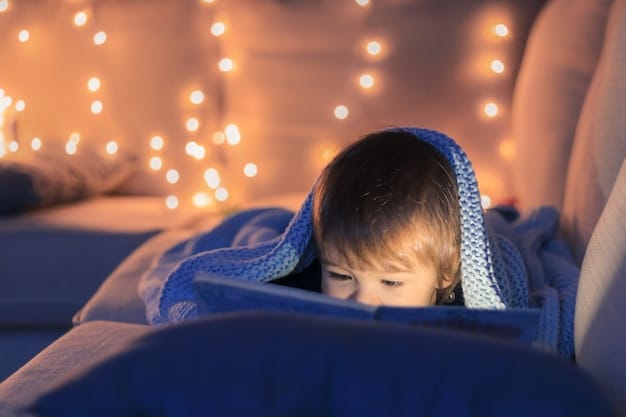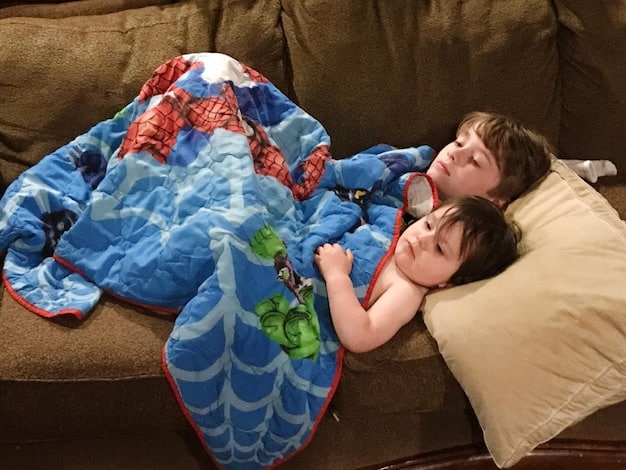Weighted Blankets for Kids: New Study Shows +90 Minutes of Sleep

A recent study suggests that weighted blankets may significantly improve sleep duration in children, potentially adding up to 90 minutes of extra sleep per night. This has sparked interest in weighted blankets as a non-pharmacological sleep aid for children.
Could a simple blanket be the key to a better night’s sleep for your child? A new study: can a weighted blanket add 90 minutes of sleep to your child’s night? is generating buzz, suggesting that these cozy covers might be more than just a fad.
Understanding the Science Behind Weighted Blankets and Sleep
Weighted blankets have gained popularity as a potential sleep aid, but how do they actually work? Understanding the science behind these blankets can help parents make informed decisions about whether they are right for their children.
The Deep Touch Pressure Effect
Weighted blankets work by providing what is known as “deep touch pressure,” a therapeutic technique that involves applying gentle, distributed pressure to the body. This pressure is thought to have a calming effect on the nervous system.
The feeling is similar to being hugged or swaddled, which can release neurotransmitters like serotonin and dopamine, both associated with relaxation and improved mood. These neurotransmitters can help reduce anxiety and promote a sense of well-being, making it easier to fall asleep.
- Reduced Anxiety: Deep touch pressure helps lower cortisol levels, the hormone associated with stress.
- Increased Serotonin: Boosts feelings of happiness and calmness, promoting relaxation.
- Improved Body Awareness: Provides a gentle grounding sensation that can help children feel more secure.

In essence, weighted blankets mimic the comforting sensation of being held, which can be particularly beneficial for children who struggle with anxiety or sensory processing issues.
The Recent Study: Key Findings and Insights
The recent study investigating the impact of weighted blankets on children’s sleep has provided some compelling insights. Let’s dive into the key findings and what they mean for parents considering this option.
Study Design and Methodology
The study involved a group of children experiencing sleep difficulties. Researchers tracked their sleep patterns and behaviors, both with and without the use of weighted blankets.
Participants were monitored over a period of several weeks, using sleep diaries and actigraphy (a method of monitoring sleep using a wrist-worn device). The data collected allowed researchers to objectively assess sleep duration, sleep quality, and the time it took to fall asleep.
The findings indicated that children using weighted blankets experienced a significant increase in sleep duration, averaging around 90 minutes more sleep per night compared to when they were not using the blankets.
- Increased Sleep Duration: Children slept an average of 90 minutes longer each night.
- Improved Sleep Quality: Participants experienced fewer nighttime awakenings and more restful sleep.
- Faster Sleep Onset: The time it took for children to fall asleep was reduced.
These encouraging results suggest that weighted blankets could be a valuable tool for addressing sleep problems in children, particularly for those who struggle with anxiety or sensory sensitivities.
Who Can Benefit Most from Weighted Blankets?
While weighted blankets may offer potential benefits for many children, some may find them particularly helpful. Understanding who can benefit most can help parents determine if a weighted blanket is a suitable option for their child.
Children with Anxiety
The deep touch pressure provided by weighted blankets can help calm the nervous system and reduce feelings of anxiety. This can be especially beneficial for children who experience anxiety that interferes with their sleep.
Children with Sensory Processing Issues
Weighted blankets can provide a sense of security and grounding for children with sensory processing challenges. The consistent pressure can help regulate sensory input, making it easier for children to relax and fall asleep.
Children with autism, ADHD, or other sensory sensitivities may find weighted blankets helpful in managing sensory overload and promoting a sense of calm. The gentle pressure can help them feel more grounded and secure, leading to improved sleep.
- Autism Spectrum Disorder: Provides sensory regulation and reduces anxiety.
- ADHD: Helps improve focus and reduces restlessness.
- Sensory Processing Disorder: Calms the nervous system and promotes relaxation.
In summary, children who struggle with anxiety, sensory sensitivities, or sleep disturbances may find significant relief and improved sleep quality through the use of weighted blankets.

How to Choose the Right Weighted Blanket for Your Child
Selecting the right weighted blanket for your child is crucial to ensure safety and effectiveness. Here are some key considerations to keep in mind when making your choice.
Weight Recommendations
The general guideline for selecting a weighted blanket is to choose one that is approximately 10% of your child’s body weight, plus one or two pounds. This weight range is typically considered safe and effective for most children.
However, it’s essential to consider your child’s individual needs and preferences. Some children may prefer a slightly heavier blanket, while others may be more comfortable with a lighter option. Always consult with your pediatrician or a healthcare professional before introducing a weighted blanket to your child.
Material and Construction
Choose a blanket made from breathable, hypoallergenic materials to ensure your child’s comfort and safety. Look for blankets with even weight distribution to prevent bunching and ensure consistent pressure.
- Breathable Fabrics: Cotton, bamboo, or other natural fibers.
- Hypoallergenic: Ideal for children with allergies or sensitive skin.
- Even Weight Distribution: Look for blankets with small, evenly distributed pockets of weighted material.
Remember to prioritize safety and comfort when selecting a weighted blanket for your child. Proper weight distribution, breathable materials, and appropriate size are essential for ensuring a positive and safe experience.
Safety Considerations and Precautions
While weighted blankets can offer many benefits, it’s crucial to prioritize safety and take necessary precautions. Keep the following considerations in mind to ensure the well-being of your child.
Age and Physical Condition
Weighted blankets are not recommended for infants or toddlers, as they may pose a suffocation risk. Children should be old enough to remove the blanket on their own if they feel uncomfortable or restricted.
It’s also essential to consider your child’s physical condition. Children with certain medical conditions, such as respiratory problems or circulatory issues, may not be suitable candidates for weighted blankets. Always consult with your pediatrician before introducing a weighted blanket to your child, especially if they have any underlying health concerns.
Signs of Discomfort
Closely monitor your child’s comfort and well-being when using a weighted blanket. Look for any signs of discomfort, such as difficulty breathing, overheating, or feeling trapped.
- Difficulty Breathing: Remove the blanket immediately if your child struggles to breathe.
- Overheating: Ensure the room is cool and your child is not sweating excessively.
- Feeling Trapped: If your child feels restricted or unable to move freely, opt for a lighter blanket or discontinue use.
By prioritizing safety and closely monitoring your child’s response to the weighted blanket, you can help ensure a positive and beneficial experience.
Integrating Weighted Blankets into a Sleep Routine
To maximize the benefits of weighted blankets, it’s essential to integrate them into a consistent and relaxing sleep routine. Here are some tips to help you implement this approach effectively.
Consistency is Key
Establish a regular bedtime and wake-up time to help regulate your child’s natural sleep-wake cycle. Consistency can help improve overall sleep quality and make it easier for your child to fall asleep.
Create a calming and relaxing environment in your child’s bedroom. Dim the lights, reduce noise, and ensure the room is at a comfortable temperature. These steps can help signal to your child’s body that it’s time to wind down and prepare for sleep.
Incorporate the weighted blanket into your child’s bedtime routine. Place it on them as you read a story, sing a lullaby, or engage in other relaxing activities. This can help associate the blanket with feelings of comfort and security, making it easier for your child to fall asleep.
- Consistent Bedtime: Helps regulate the body’s natural sleep-wake cycle.
- Calming Environment: Creates a relaxing atmosphere conducive to sleep.
- Bedtime Routine: Signals to the body that it’s time to wind down and prepare for sleep.
By integrating weighted blankets into a structured sleep routine, you can help create a positive association and maximize their effectiveness in promoting better sleep for your child.
| Key Point | Brief Description |
|---|---|
| 😴 Sleep Duration | Weighted blankets may add up to 90 minutes of sleep. |
| 🧸 Anxiety Reduction | Deep touch pressure can lower cortisol levels. |
| ⚖️ Weight Choice | Aim for 10% of body weight, plus 1-2 pounds. |
| ⚠️ Safety First | Not for infants; monitor for discomfort. |
Frequently Asked Questions (FAQ)
▼
Weighted blankets are generally safe for children over the age of two. However, it is crucial to consult with a pediatrician before use, especially for children with pre-existing medical conditions. Always monitor your child’s comfort.
▼
A general recommendation is for the weighted blanket to be approximately 10% of the child’s body weight, plus one or two pounds. Adjust as needed, focusing on ensuring maximum comfort and safety.
▼
Yes, weighted blankets may help reduce anxiety by providing deep touch pressure. This can promote relaxation and a sense of security, making it easier for a child to fall asleep without being overwhelmed.
▼
Choose breathable and hypoallergenic materials like cotton or bamboo. These will provide comfort and reduce the risk of irritation, so that your child can rest easily all throughout the night with a blanket that is gentle on their skin.
▼
Check the care label. Many weighted blankets are machine washable, but some might require hand washing or spot cleaning. Ensure it dries completely to prevent mold or mildew, for long lasting use.
Conclusion
The recent study highlighting the potential of weighted blankets to enhance sleep duration in children offers encouraging insights for parents seeking non-pharmacological sleep solutions. By understanding the science behind weighted blankets, choosing the right one for your child, and prioritizing safety, you can explore a potentially valuable tool for promoting better sleep and overall well-being.





